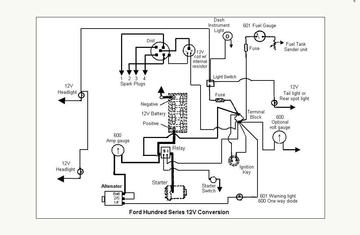Wiring and Gauges
Lights;
All light bulbs will need to be replaced with 12V bulbs including your dash instrument light.
The fuel gauge will need to be replaced with a 12V gauge but the old 6V sending unit in the tank will work.
The oil pressure and water temperature gauges use no electivity so they can stay.
Your amp gauge will need to be replaced so let me recommend you replace it with a volt gauge. Volt gauges are much better for these tractors.
You will need a terminal block that is mounted under the dash. If yours is shot you can get one from AutoZone for about $3.00. Some have only one screw per circuit and some have two screws joined by a short piece of metal. You will need a terminal block with two circuits. One circuit for the power side of the key and one circuit for power only with key on. So now we have all our parts installed on the tractor and it is time to wire every thing together.
Print out this wiring diagram so you can follow along. 
While we will wait till last to install and hook up the battery lets start with the biggest wires first. Battery cables;
Battery negative post to a good engine ground
Battery positive post to the left side of starter relay
Right side of relay to starter 10 Gauge wire;
Alternator battery post to the left (battery) side of relay. You can put your amp gauge in this wire if you are going to use one. If you hook it up wrong and it reads backwards just remove and install the wires on the opposite post of the gauge.
Left (battery) side of relay to the hot side of the terminal block. All the rest of the wires are 12 gauge. While you may be able to use 14 gauge wire I always use 12 gauge wire as it does not cost much more; Hot side of terminal block to……..
Key
Inline fuse and then to light switch and lights. Power only with key on side of terminal block to…..
Other side of key
Positive side of coil. This is the wire you need a resistor in if you are using the 6v coil or the 12v with external resistor.
I post on starter relay (Note; if you have the 3 post starter relay just leave this wire off)
#1 of F post on alternator. This is the wire you need a warning light or a one way diode. Some way to break back feed from alternator.
Volt gauge if you are using one.
Inline fuse and then to fuel gauge Almost done. Now we need a 12 gauge wire from…….
The #2 or S post on the alternator to the battery post on the alternator
Fuel gauge to the fuel sender
Negative side of coil to distributor points
S post on starter relay to starter switch on the transmission Now you can hook up the battery and start it up. Check to see that the fan belt is running correctly. Take a volt meter and set it on 20 volts DC. Put the red lead on the positive battery post and the black lead on the negative battery post. You should have a reading of 14 volts give or take 0.5 volts. If so you are charging and it now time to set back and enjoy you new 12v system.
| 




